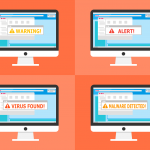The early days of search engines were reminiscent of the wild west. Underhanded or downright malicious search engine optimization (SEO) was commonplace, and many of the top spots on the search engine results page were taken up by low-quality, misleading spam sites. It didn’t take long for Google to correct the issue, and it’s been leveling increasingly harsh penalties against the tactics used by spammers and bad actors, collectively known as black hat SEO.
Unfortunately, black hat practitioners appear to have missed the memo. Negative SEO attacks are on the rise, driven as much by unscrupulous site owners as by cybercriminals. Today, we’re going to tell you how to protect yourself against them.
What is Negative SEO?
Negative SEO refers to a specific branch of black hat SEO that involves targeting other websites rather than attempting to improve one’s own page rank. Although the motivations may differ, the end goal of negative SEO is to sabotage another company’s SEO efforts. In some cases, a bad actor might even attempt to directly hack or compromise a website.
What are the Most Common Types of Negative SEO Attack?
Common negative SEO techniques include:
- Directly hacking a website.
- Using link farms or public blog networks to drown a competitor’s site in toxic backlinks.
- Content scraping.
- Fake reviews.
- Fraudulent backlink removal requests.
- Fraudulent DMCA takedowns.
How Do You Stop a Negative SEO Attack?
The short answer is that it depends on the type of attack. The long answer is that in some cases, it’s difficult to know for certain if your website is even being targeted by negative SEO. Some webmasters are quick to blame external factors for their declining page rank, which may cause them to overlook their own mistakes.
Before you assume you’re being targeted, ask yourself the following questions:
- Has Google recently updated its algorithm?
- When did you last perform a backlink audit?
- When did you last test your website with PageSpeed Insights?
- Are there any recent industry changes that could explain this?
- Has a competitor started outperforming you because they simply have a higher-quality, better-optimized site?
- Does your website use HTTPS?
- Is your website optimized for mobile devices?
Once you’ve ruled out the factors above, the following steps can help keep you safe from a negative SEO attack—even one that’s in progress.
- Check your backlink profile for toxic links using a tool like Ahrefs.
- Disavow each unnatural link you uncover.
- Leverage a tool like Copyleaks to manually search for stolen or scraped content, or a platform like DataDome for automated protection.
- Every time you see a negative review about your business, make an effort to reach out to the reviewer and rectify the situation, reporting any obviously fake reviews.
- Enable spam protection and multifactor authentication on your website, and ensure that you have a secure username and password.
Conclusion
At the end of the day, most negative SEO practitioners are doing it because they’re either too lazy or too talentless to achieve genuine success; they think they can get away with taking a shortcut instead. The reality is that as Google’s algorithms continue to improve, the efficacy of negative SEO continues to decrease.
For the most part, as long as your SEO is up to par, you should be fine.





